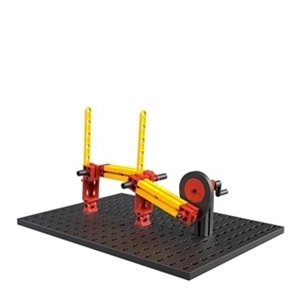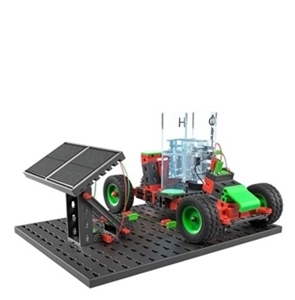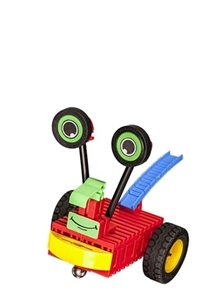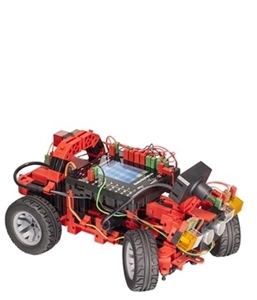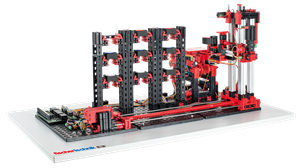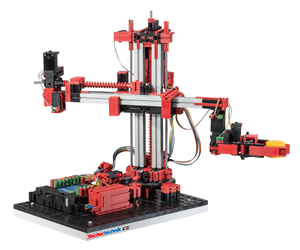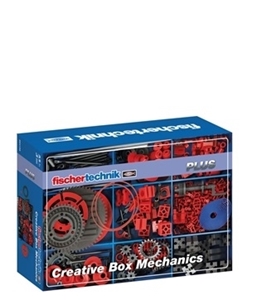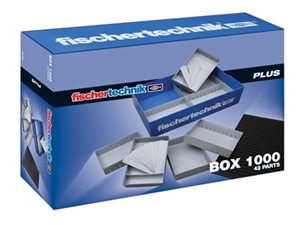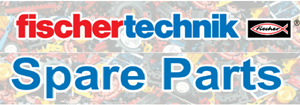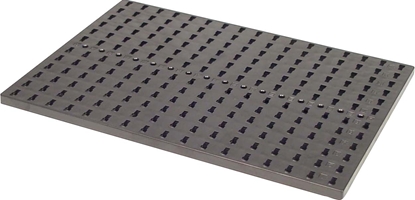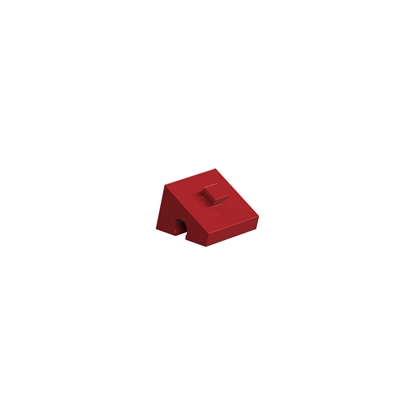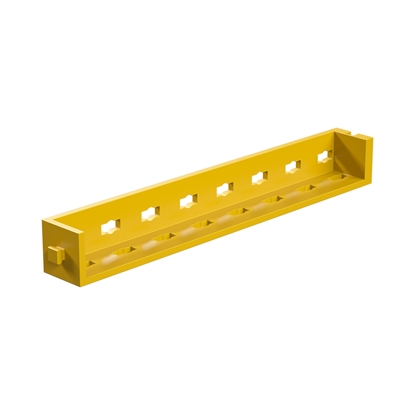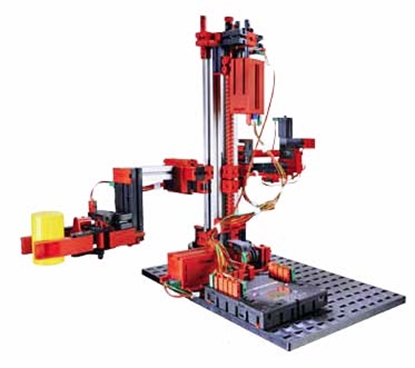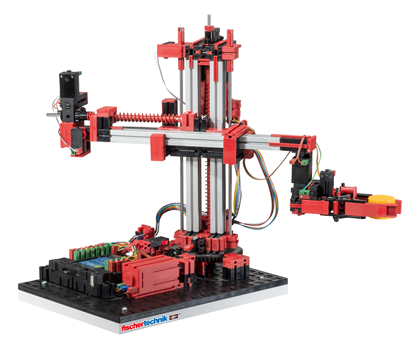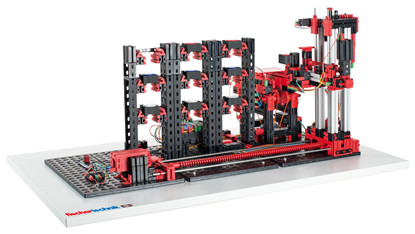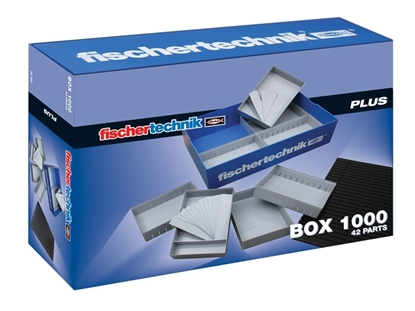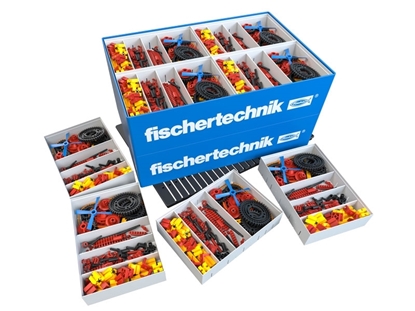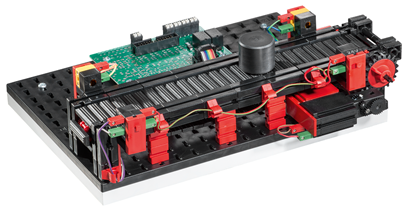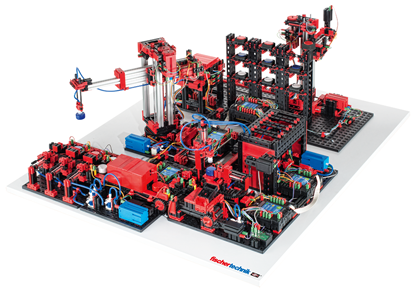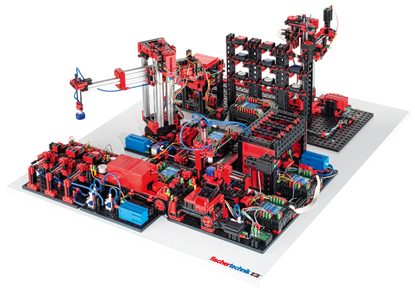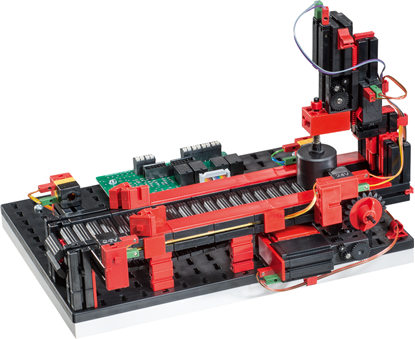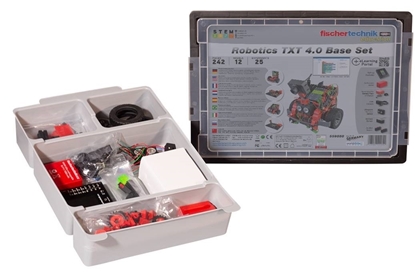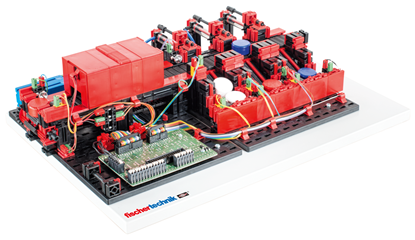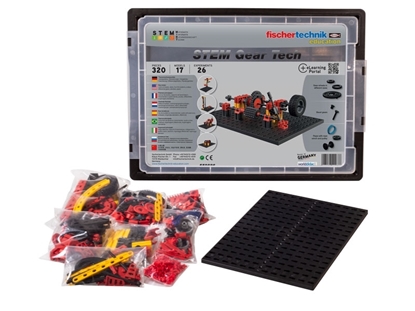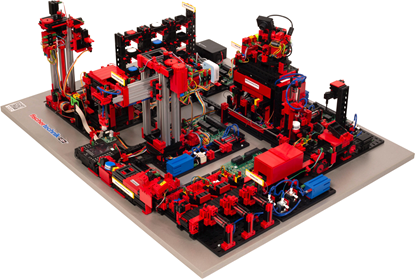Fischertechnik
Fischertechnik
32985: fischertechnik Base Plate for Sorting Box
fischertechnik Base Plate for Sorting Box helps keep your fischertechnik components secure. Use this base plate to line your fischertechnik Sorting Box 500 (258 x 186m).
fischertechnik 3-D Robot 24V for use w/PLC (not included)
fischertechnik Industrial Simulation Robot - in 9 V and 24 V Versions
3-axis robot with gripping device.
Degrees of freedom:
- Shaft 1: Rotation 180°
- Shaft 2: Forward/back 90 mm
- Shaft 3: Up/down 150 mm
Scope of Delivery:
- 4 DC motors, including 2 with integrated magnetic encoder (Max. pulse frequency: 1 kHz)
- 4 Limit switches, 2 pulse sensors for path measurement
- 8 Digital inputs
- 8 Outputs, 9V –.../24V –... (4 Motors clockwise/counterclockwise rotation, 24V version incl. relay board for motor polarity reversal)
- Large model: approx. 390x200x30 mm (LxWxH).
- Model mounted on stable wooden board.
- Robotics TXT Controller included with 9 V version ONLY. 24 V version has screw terminals and requires PLC.
- Model can be ideally combined with conveyor belt, punch press and intermittent assembly line.
9 V version requires Power Set #91087 or Power Supply #122952 for operation (Not Included). 24 V version requires PLC (not included).
fischertechnik 3-D Robot 9V (fully wired with Robotics TXT Controller included)
fischertechnik Industrial Simulation Robot - in 9 V and 24 V Versions
3-axis robot with gripping device.
Degrees of freedom:
- Shaft 1: Rotation 180°
- Shaft 2: Forward/back 90 mm
- Shaft 3: Up/down 150 mm
Scope of Delivery:
- 4 DC motors, including 2 with integrated magnetic encoder (Max. pulse frequency: 1 kHz)
- 4 Limit switches, 2 pulse sensors for path measurement
- 8 Digital inputs
- 8 Outputs, 9V –.../24V –... (4 Motors clockwise/counterclockwise rotation, 24V version incl. relay board for motor polarity reversal)
- Large model: approx. 390x200x30 mm (LxWxH).
- Model mounted on stable wooden board.
- Robotics TXT Controller included with 9 V version ONLY. 24 V version has screw terminals and requires PLC.
- Model can be ideally combined with conveyor belt, punch press and intermittent assembly line.
9 V version requires Power Set #91087 or Power Supply #122952 for operation (Not Included). 24 V version requires PLC (not included).
fischertechnik Automated High Bay Warehouse 24V Version (For use with PLC which is required but not included)
Transfer station with conveyor belt, with shelf stacker for storing and retrieving special workpiece carriers, and 9 storage spots. Fully assembled training model, wired to pre-programmed fischertechnik ROBOTICS TXT Controller.
fischertechnik Box 1000
Practical storage box with eight sorting boxes and 32 sorting partitions. The cover also serves as the big building board 390 x 270 mm.
fischertechnik CLASS Set Gears
Make the basics of different types of gears in primary education understandable and ensure lasting comprehension!
How does a cone gear wheel, a belt drive or a rack and pinion drive work? What happens if the gear ratio changes? Young researchers can discover the answers to these and many other questions through 15 models and twelve experiments. The models are quick and easy to build in the classroom, and the pre-designed tasks and solutions are a great addition. A class set contains 16 individual sets and is suitable for 30 pupils and one teacher, for example.
Accompanying teaching material:
fischertechnik Education products include comprehensive, freely accessible teaching materials. These have been developed together with teacher training colleges, teachers and didacticians and are ideally suited to the needs of the classroom. In addition to the topic introduction, lesson plans with task sheets and educational plan references are available.
- The topic introduction provides content that can be optimally used for lesson preparation and integrated into the lessons. Definitions, history, basic knowledge and much more are provided.
- The teaching material includes an overview of the learning objectives as well as the time required for the tasks.
- In line with the curriculum-relevant topics, various tasks are included within which different experiments are dealt with.
- The tasks are divided into a construction task, thematic task and experimentation task. In this way, one progresses from building, to learning technical content, to applying the acquired knowledge.
Highlights:
- Simple gear types
- Translations
- Directions of rotation
- Types of movement of gearboxes
fischertechnik Conveyor Belt 24V
Conveyor belt simulates the transport of the workpieces
Transport belt with a length of 275 mm transports workpieces with a diameter of up to 29 mm. Several conveyor belts can be connected to each other to form an endless conveyor belt. The model is ideally combinable with the training model "3-axis robot with gripper".
Connection to PLC control: The model has a circuit board with relays for reversing the direction of rotation of the motors. All inputs and outputs can be connected to a jack plug (26-pin, 2.54 mm pitch) or to series terminals with push-in terminals.
Technical details:
- Inputs digital: 3
- Outputs 24V: 1
fischertechnik Factory Simulation 24V
Automated training and simulation factory
Advantages:
- Ideal training, simulation and demonstration model for training and industrial automation
- Already completed, stable training model
- Mounted on a solid wooden plate, model packaged in a sturdy cardboard box
- Optionally available in the 9V standard voltage as well as in the worldwide 24V industrial standard
- REQUIRES a PLC for 24V operation
fischertechnik Factory Simulation 9V
The fischertechnik Factory Simulation combines four models --Vacuum Gripper Robot, Automated High Bay Warehouse, Multi-Processing Station with Oven, and the Sorting Line with Color Detection--into one self-contained material cycle.
Workpieces are retrieved from the Automated High Bay Warehouse using the Vacuum Gripper Robot, and then moved to the Multi-Processing Station with Oven. After the workpiece has been processed by this machine, it is then sorted by color in the Sorting Line with Color Detection, before being again moved by the Vacuum Gripper Robot to the Automated High Bay Warehouse for storage. Pre-assembled training model, wired to 5 fully programmed fischertechnik ROBOTICS TXT Controllers.
fischertechnik Punching Machine with Conveyor Belt 24V - Education
Simulation of transport and machining of workpiecesl
The punching machine with conveyor belt simulates conveying and punching of workpieces. The model is ideally combinable with the training model "3-axis robot with gripper".
Connection to PLC control: The model has a circuit board with relays for reversing the direction of rotation of the motors. All inputs and outputs can be connected to a jack plug (26-pin, 2.54 mm pitch) or to series terminals with push-in terminals.
Technical details:
- Inputs digital: 4
- Outputs 24V: 4
fischertechnik Robotics TXT 4.0 Base Set
Measurement, control, regulation and programming from secondary level onwards The fischertechnik Robotics TXT 4.0 Base Set is the perfect start to programming like the pros! In addition to the camera with image processing, the extensive construction kit contains an ultrasonic sensor, two encoder motors, a track sensor, a phototransistor as well as two push buttons and two LEDs.
The models can be programmed and controlled with the ROBO Pro Coding programming software and the ROBOTICS TXT 4.0 controller. Beginners can access ready-made sample programs,while advanced and professionals can get started directly in a Blockly programming environment or in Python.
With an additional app (Android/ iOS), the TXT 4.0 controller can also be controlled via voice recognition. Included are 12 exciting models ranging from pedestrian traffic lights, a barrier, a barcode scanner to mobile driving robots with encoder motors, camera, lane and distance sensor. In addition to introductory and basic information, the comprehensive teaching material includes 20 experiments with solutions for the 12 models.
fischertechnik Sorting Line with Color Detection 24V
System for detecting workpieces of different colors and sorting them via a conveyor belt into three different storage bins. Fully assembled training model, wired to pre-programmed fischertechnik ROBOTICS TXT Controller.
fischertechnik STEM Gear Tech
Make the basics of different types of gears in secondary education understandable and ensure lasting comprehension!
17 exciting models ready for discovery by the technicians of the future! Students can complete X fun experiments using models like a beam balance, a scissors lift or a windscreen wiper to learn about the exciting technology behind them. Of course, they can also build all kinds of different gears, like a clockwork mechanism, different planetary gears or a differential gear. Additional free materials are available online to help teach about these concepts.
Accompanying teaching material:
fischertechnik Education products include comprehensive, freely accessible teaching materials. These have been developed together with teacher training colleges, teachers and didacticians and are ideally suited to the needs of the classroom. In addition to the topic introduction, lesson plans with task sheets and educational plan references are available.
- The topic introduction provides content that can be optimally used for lesson preparation and integrated into the lessons. Definitions, history, basic knowledge and much more are provided.
- The teaching material includes an overview of the learning objectives as well as the time required for the tasks.
- In line with the curriculum-relevant topics, various tasks are included within which different experiments are dealt with.
- The tasks are divided into a construction task, thematic task and experimentation task. In this way, one progresses from building, to learning technical content, to applying the acquired knowledge.
Highlights:
- Lever principles
- Ratios
- Four-link systems
- Pulleys
- Differential gears
- Planetary gears
fischertechnik Training Factory Industry 4.0 24V
The fischertechnik learning environment is used for learning and understanding industry 4.0 applications in vocational school and training and for use in research, teaching and development at universities, in companies and IT departments. The simulation depicts the ordering process, the production process and the delivery process in digitized and networked process steps.
Factory photo
The Training Factory consists of the factory modules storage and retrieval station, vacuum gripper robot, high-bay warehouse, multi-processing station with oven, a sorting line with colour detection, an environmental sensor and a swivelling camera. After delivery of raw materials, they are stored in the high-bay warehouse and after ordering in the dashboard, the workpieces pass through the respective factory modules and the current status is immediately visible in the dashboard.
The integrated environmental sensor reports values for temperature, humidity, air pressure and air quality. Due to the vertical and horizontal swivel range, the camera can see the entire plant and can therefore be used for web-based remote monitoring.
The individual workpieces are tracked by NFC (Near Field Communication): each workpiece is given a unique identification number (ID). This enables the current status of the workpieces in the machining process to be tracked and made visible..
Control
The Training Factory 4.0 24V is controlled by a PLC (brand independent, not included in the scope of delivery) and has a ready-made example program (as Structured Text, ST) included in the scope of delivery. The program was created on the basis of a Siemens S7-1500 (for details see on this page under ""Downloads"").
The newly developed 24V adapter boards as interface to the PLC are pre-assembled in the learning factory and are connected to the PLC via terminals. Among other things, this latest generation of adapter boards allows
- The encoder motors are controlled in speed via PWM
- There are push/pull output stages for phototransistors and buttons
A fischertechnik TXT controller is also installed. This is supplied with power via the adapter board and provides the connection to the fischertechnik cloud. The TXT controller also communicates in MQTT to the IOT gateway (Raspberry Pi), which in turn translates in OPC-UA to the PLC controller. In this way, the 9V-based components such as the environmental sensor, the USB camera, the brightness sensor and the NFC reader can be addressed via the MQTT interface and read out by the PLC. Even more interesting, however, is another function of the IOT Gateway, namely the possibility of an optional connection to a separate cloud. Thus, Training Factory 4.0 offers maximum flexibility for the respective user.
Software
The PLC program for controlling fischertechnik Training Factory 4.0 was created as structured text (ST) based on a Siemens S7-1500 and can be called up in the eLearning portal. It can also be viewed, used and downloaded free of charge at Github.com/fischertechnik. Of course, the Learning Factory can also be controlled with other PLC models and brands and individual solutions can be programmed and implemented by the user. It may be necessary to make small adjustments to the example program, which can then be implemented independently.
fischertechnik Cloud
The connection to the fischertechnik cloud is established via the WLAN router which is integrated in the learning factory. The use of the Chrome or Firefox web browsers is recommended. www.fischertechnik-cloud.com. The servers of the cloud are located in Germany and ensure that the strict European requirements apply for the storage of data. Personal data is protected in an account with password access, which uses the very secure ""OAuth2"" industry standard. All data sent to the cloud is encrypted with certificates (https standard).
2 Dashboards, Raspberry Pi and Node-RED
The fischertechnik dashboard in the cloud can be called up and operated via mobile devices such as tablet and smartphone as well as on laptop and PC. In addition, a local dashboard, created with Node-RED, is implemented on the Raspberry Pi (IOT gateway), and own dashboards can also be created via Node-RED.
The dashboards included in Lernfabrik 4.0 enable the presentation of platforms from three different perspectives:
- Customer view
- Supplier view
- Production view
The customer view shows a webshop interface with a shopping cart, where you can order a workpiece and track the current status of the order in the shopping cart. This process is displayed on the interface for the customer so that he/she is informed about the status of his/her order.
The process of ordering the raw material is displayed and visualised in the supplier view.
The factory status, the production process, the stock, the NFC/RFID reader and the sensor values can be queried in the production view. In addition, the camera that monitors the production line can also be controlled here. All these functions are controlled within a window and actuated via the menu.
In Factory status, the status of the respective module is visualised via a traffic light display. If a fault occurs in production, it is acknowledged via a button after the cause has been rectified and production is continued.The individual manufacturing steps are visually simplified using connected nodes and represented in the Production process view. The currently active node (= production module) lights up green or red when the respective process step is being processed live or there is an error and is waiting to be corrected.
The Inventory production view visualises the current inventory of workpieces including minimum and maximum stock. A reorder point procedure is stored. This production view is used exclusively for visualisation.The production view of the NFC/RFID reader displays the workpiece data and can be used to read or delete workpieces manually. The raw data of the NFC tags can be read using a standard NFC app from mobile devices with NFC readers. Each workpiece has its own unique ID and displays the following data: Status, colour and timestamp from delivery to dispatch.The camera is also controlled via the production view and the read values of the environment sensor can also be viewed here.
AV/VR, Digital Twin
All fischertechnik training and simulation models can also be ideally used for digital applications and demonstrators. We will be happy to provide you with the necessary CAD data.
Advantages:
- Enables in-depth learning through haptic comprehension on a realistic production image
- Digital traceability through NFC/RFID, remote monitoring via camera, sensor applications
- Integrated cloud connection with dashboard, control via smart devices, own cloud and dashboard can be integrated, node-RED interface
- Communication via OPC/UA and MQTT
- Including completely written PLC program as ST (structured text)
In the training model included:
- Raspberry Pi (IOT Gateway)
- NFC/RFID Reader and NFC-Tag
- environment sensor
- USB-camera
- WLAN router
- storage and retrieval station
- Boards of the latest generation


